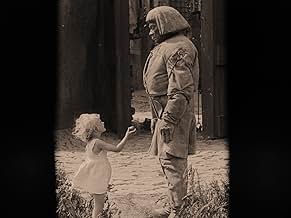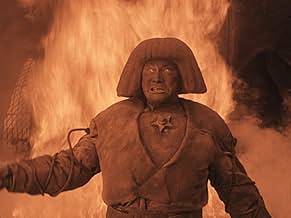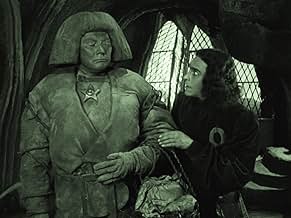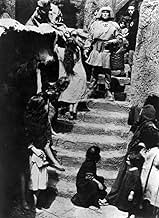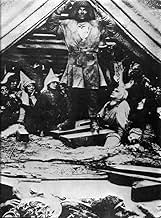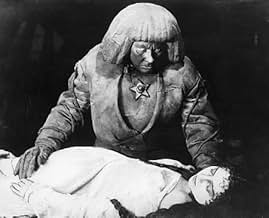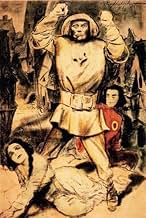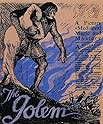NOTE IMDb
7,2/10
9,1 k
MA NOTE
Au 16e siècle, à Prague, un rabbin crée le Golem, une créature géante faite d'argile. Grâce à la sorcellerie, il donne vie à la créature afin de protéger les Juifs de Prague des persécutions... Tout lireAu 16e siècle, à Prague, un rabbin crée le Golem, une créature géante faite d'argile. Grâce à la sorcellerie, il donne vie à la créature afin de protéger les Juifs de Prague des persécutions.Au 16e siècle, à Prague, un rabbin crée le Golem, une créature géante faite d'argile. Grâce à la sorcellerie, il donne vie à la créature afin de protéger les Juifs de Prague des persécutions.
- Réalisation
- Scénario
- Casting principal
- Récompenses
- 1 victoire et 1 nomination au total
Hans Stürm
- Der Rabbi Jehuda, der Älteste der Gemeinde
- (as Hans Sturm)
Carl Ebert
- Temple Servant
- (non crédité)
Fritz Feld
- Jester
- (non crédité)
Loni Nest
- Ein kleines Mädchen
- (non crédité)
- …
Ursula Nest
- Little Girl
- (non crédité)
Dore Paetzold
- Des Kaisers Kebse
- (non crédité)
- …
Märte Rassow
- Kind
- (non crédité)
Avis à la une
I caught this restored version of the 1920 German silent classic at Lincoln Center where a new musical score was premiered by the Chamber Music Society. I had never seen the film before and was frankly amazed at the imagery in the sets and costumes and editing of the film. The film's director, Paul Wegener, wearing a thickly padded outfit and wig and high-heeled boots plays the main character, "The Golem". A mythical character from Jewish folklore. For its day, the special effects were also intriguing. I resist describing the movie as anti-semitic but I believe that the portrayal of the jewish ghetto was depicted so dramatically to show that the jews in Prague were outsiders and not welcome in mainstream society. This is evident in the fact that when a nobleman comes to the ghetto, he is greeted by a mammoth closed gate that looks like a precursor to the one used in King-Kong. And most notably, during the creation sequence, a satanic figure appears on screen that would coincide with the European belief a that time that Jews walk hand-in-hand with the Dark forces.
As far as the Golem's performance- this film is really a precursor to "Frankenstein" that Boris Karloff must have seen in its original release - there are so many similarites.
Biggest Image - at the conclusion, the Golem is surrounded by a group of "blond" Aryan-looking children that clearly distinguish them from the ghetto children that we see earlier in the film.
As far as the Golem's performance- this film is really a precursor to "Frankenstein" that Boris Karloff must have seen in its original release - there are so many similarites.
Biggest Image - at the conclusion, the Golem is surrounded by a group of "blond" Aryan-looking children that clearly distinguish them from the ghetto children that we see earlier in the film.
This landmark film is one of the earliest surviving expressionist works, and it's art direction and photography-- while not as stunning as a film like Caligari-- is still extremely interesting with its misshapen sets and its use of light and shadow, and light within shadow. Unlike Caligari, the themes of this film were resonant long after its release, and perhaps still are today.
The Golem is a tolerance film that studies in depth the relationship between Jews and Christians in Prague. To his credit, Wegener refuses to impose stereotypes on either party, instead concentrating on individual characters and using mass characterizations only to highlight the themes of the film.
Unlike stereotypical Jews, rich guys with big noses who rub pennies together, the Jews of Prague are decidedly poor. It is interesting to note that the Jews are all dressed in black and with very few exceptions appear to be bent with age, a tribute to an aging and dying religion. However, they are also portrayed to be earnest and hard-working, with strong communal instincts. The Christians, by contrast, appear bright, shiny, and new. They are dressed in light colors and are young and wealthy, and outwardly appear to be God's new chosen. However, they are also portrayed as foolish bohemians who do not take God seriously. In the end, Christian innocents (and blonde-blue Aryan, coincidentally)are able to stop the Golem's rampage, but only because he allows it. The final shot shows the Star of David lying in the dust as the Jews come to carry their fallen champion back into the ghetto, closing the great door behind them and leaving you with a feeling that they are gone forever. However, it should be noted that the Golem is not only a champion to the Jews, but a symbol of revival.
Another interesting comparison in this film is that between the Golem and Jesus. Like man, the Golem is made of sand and clay, then given life by a supernatural force. They are both immaculate conceptions, with the Golem being motherless while Jesus is born to a virgin mother. Jesus in his time was a champion of the Jews, as is the Golem, and each of them rebelled against the wickedness of the authorities that governed them.
This open-ended presentation of the struggle of Christianity vs. Judaism is what makes this film truly great. I suspect that this relevant elevation above the ordinary is the reason for its survival, even though it is the third film of this series. The fact that Wegener was able to make a film that is so ambiguous is a credit to him considering the circumstances surrounding German film-making at the time.
Rabbi Loew is portrayed as a wise and heroic leader of the Jewish community, which lives in a winding ghetto. He creates the Golem for a noble cause-- to protect his people against eviction by the Christians--and in this cause succeeds after the Christian court is saved by the Golem from divine repudiation after laughing at Loew's presentation of the Old Testament. The creation scene is particularly interesting, not only in its visuals, but for the fact that in this scene Rabbi Loew wears white (for purity), yet performs a ceremony that is holy in nature yet seems like witchcraft. The Golem turns on him when he seeks to continue using the Golem's services for selfish purposes after the Golem has accomplished his mission.
Miriam and Loew's servant are portrayed quite differently. Miriam is a dark seductress who is unwittingly the cause of the Golem's destructive rampage. She is only saved from the hands of the Golem by another act of divine intervention, when the communal prayer of the Jews in the streets of the ghetto results in her release. She usually dresses in dark colors. However, there is also a scene before her affair with Florian in which she wears white (purity of a different kind). Also notice how Florian carelessly twirls a flower when he delivers the edict to Rabbi Loew. This is a brief, but effective, example of his character and foreshadows things to come. Loew's servant is the only other young Jewish character in the film besides a few Jewish children in the street, and it is his revival of the Golem during his jealous rage against Florian that sets the Golem on his destructive path. Like Loew, he is unable to remove the Star of David from the Golem's chest once he begins to use the Golem for selfish gain. In the end, he shares a poignant moment with Miriam where they seek forgiveness and confidence about their actions.
The depth and attention to detail that Wegener shows as a director (and writer) in this film helps to place it among the great films in the brief history of cinema. It's message is particularly haunting considering the events of the next 25 years after its release.
The Golem is a tolerance film that studies in depth the relationship between Jews and Christians in Prague. To his credit, Wegener refuses to impose stereotypes on either party, instead concentrating on individual characters and using mass characterizations only to highlight the themes of the film.
Unlike stereotypical Jews, rich guys with big noses who rub pennies together, the Jews of Prague are decidedly poor. It is interesting to note that the Jews are all dressed in black and with very few exceptions appear to be bent with age, a tribute to an aging and dying religion. However, they are also portrayed to be earnest and hard-working, with strong communal instincts. The Christians, by contrast, appear bright, shiny, and new. They are dressed in light colors and are young and wealthy, and outwardly appear to be God's new chosen. However, they are also portrayed as foolish bohemians who do not take God seriously. In the end, Christian innocents (and blonde-blue Aryan, coincidentally)are able to stop the Golem's rampage, but only because he allows it. The final shot shows the Star of David lying in the dust as the Jews come to carry their fallen champion back into the ghetto, closing the great door behind them and leaving you with a feeling that they are gone forever. However, it should be noted that the Golem is not only a champion to the Jews, but a symbol of revival.
Another interesting comparison in this film is that between the Golem and Jesus. Like man, the Golem is made of sand and clay, then given life by a supernatural force. They are both immaculate conceptions, with the Golem being motherless while Jesus is born to a virgin mother. Jesus in his time was a champion of the Jews, as is the Golem, and each of them rebelled against the wickedness of the authorities that governed them.
This open-ended presentation of the struggle of Christianity vs. Judaism is what makes this film truly great. I suspect that this relevant elevation above the ordinary is the reason for its survival, even though it is the third film of this series. The fact that Wegener was able to make a film that is so ambiguous is a credit to him considering the circumstances surrounding German film-making at the time.
Rabbi Loew is portrayed as a wise and heroic leader of the Jewish community, which lives in a winding ghetto. He creates the Golem for a noble cause-- to protect his people against eviction by the Christians--and in this cause succeeds after the Christian court is saved by the Golem from divine repudiation after laughing at Loew's presentation of the Old Testament. The creation scene is particularly interesting, not only in its visuals, but for the fact that in this scene Rabbi Loew wears white (for purity), yet performs a ceremony that is holy in nature yet seems like witchcraft. The Golem turns on him when he seeks to continue using the Golem's services for selfish purposes after the Golem has accomplished his mission.
Miriam and Loew's servant are portrayed quite differently. Miriam is a dark seductress who is unwittingly the cause of the Golem's destructive rampage. She is only saved from the hands of the Golem by another act of divine intervention, when the communal prayer of the Jews in the streets of the ghetto results in her release. She usually dresses in dark colors. However, there is also a scene before her affair with Florian in which she wears white (purity of a different kind). Also notice how Florian carelessly twirls a flower when he delivers the edict to Rabbi Loew. This is a brief, but effective, example of his character and foreshadows things to come. Loew's servant is the only other young Jewish character in the film besides a few Jewish children in the street, and it is his revival of the Golem during his jealous rage against Florian that sets the Golem on his destructive path. Like Loew, he is unable to remove the Star of David from the Golem's chest once he begins to use the Golem for selfish gain. In the end, he shares a poignant moment with Miriam where they seek forgiveness and confidence about their actions.
The depth and attention to detail that Wegener shows as a director (and writer) in this film helps to place it among the great films in the brief history of cinema. It's message is particularly haunting considering the events of the next 25 years after its release.
In 16th-century Prague, a Jewish rabbi (Albert Steinrück) creates a giant creature from clay, called the Golem, and using sorcery, brings the creature to life in order to protect the Jews of Prague from persecution.
Called "one of the most ambitious productions of the silent era" by Mike Mayo, the film is a blend of religion, astrology and black magic -- mixing Judaism with a conjuring of the demon Astaroth.
The film also has an interesting presentation of anti-Semitism, where the emperor accuses the Jews of killing Christ, among other things, and orders them to evacuate the ghetto. How did Germany in 1920 feel about the Jews? We now know how they felt a decade later, but was this hatred always there or invented by Hitler? If it existed, how did it translate to this film's reception by the German people?
Paul Wegener's face is a wealth of visions -- he manages to use his eyes in such a way that present the golem as simultaneously stoic and intensely emotional.
Others have pointed out that Karl Freund's camera is remarkably still for a man who would go on to be known for the most innovative camera techniques in film history (I dare say he is the greatest cinematographer who ever lived). Mayo says there is an "inventive use of extreme camera angles", but I did not notice. The lack of movement does not hinder the film, however.
Lee Price praises the film, saying the only fault of the film is "the inconsistency of the acting", though I did not find it distracting at all (even if the frightened faces of the extras are a bit extreme). Price calls the architecture of the film as influential (or more so) than the German Expressionism of "Caligari". He is not alone in this view: Ivan Butler makes a point to mention the "strange twisted buildings and crooked streets filled with steeple-hatted inhabitants", and Siegfried Kracauer singles out the "maze of crooked streets and stooped houses" devised by Professor Hans Poelzig.
If you are to see or own this film, I recommend the Kino DVD. Not only is the film cleaned up nicely, with a wonderful score and English title cards, but the supplements are beyond what one would expect from such an old film -- featurettes comparing this movie to "Faust" and the later "Le Golem". I enjoyed them.
Called "one of the most ambitious productions of the silent era" by Mike Mayo, the film is a blend of religion, astrology and black magic -- mixing Judaism with a conjuring of the demon Astaroth.
The film also has an interesting presentation of anti-Semitism, where the emperor accuses the Jews of killing Christ, among other things, and orders them to evacuate the ghetto. How did Germany in 1920 feel about the Jews? We now know how they felt a decade later, but was this hatred always there or invented by Hitler? If it existed, how did it translate to this film's reception by the German people?
Paul Wegener's face is a wealth of visions -- he manages to use his eyes in such a way that present the golem as simultaneously stoic and intensely emotional.
Others have pointed out that Karl Freund's camera is remarkably still for a man who would go on to be known for the most innovative camera techniques in film history (I dare say he is the greatest cinematographer who ever lived). Mayo says there is an "inventive use of extreme camera angles", but I did not notice. The lack of movement does not hinder the film, however.
Lee Price praises the film, saying the only fault of the film is "the inconsistency of the acting", though I did not find it distracting at all (even if the frightened faces of the extras are a bit extreme). Price calls the architecture of the film as influential (or more so) than the German Expressionism of "Caligari". He is not alone in this view: Ivan Butler makes a point to mention the "strange twisted buildings and crooked streets filled with steeple-hatted inhabitants", and Siegfried Kracauer singles out the "maze of crooked streets and stooped houses" devised by Professor Hans Poelzig.
If you are to see or own this film, I recommend the Kino DVD. Not only is the film cleaned up nicely, with a wonderful score and English title cards, but the supplements are beyond what one would expect from such an old film -- featurettes comparing this movie to "Faust" and the later "Le Golem". I enjoyed them.
Although this 1920 German silent does not really rank alongside the truly great silent films, it remains a fascinating oddity. Based on European Jewish folklore, it tells the story a Jewish community in Prague which is threatened with expulsion from the city. In an effort to protect his people, Rabbi Loew creates a man-like creature made of clay and uses it to impress the Emperor. Unfortunately, the magic backfires, and when the Golem falls into the hands of the Rabbi's perfidious assistant disaster results.
Much of the film's charm is in its visual style. The sets by Hans Poelzig are a strange but cohesive mixture of medieval, nouveau, and surrealism, and the cinematography by legendary photography Karl Freund uses high contrast black and white to truly remarkable effect. The Poelzig-Freund combination would cast an extremely long shadow, and THE GOLEM would influence not only such German films as Fitz Lang's METROPOLIS but the entire cycle of 1930s American horror films that began with the 1931 Bela Lugosi Dracula.
Several plot devices and the look of the Golem, as played by Paul Wegener, would also prove particularly influential for director James Whale's famous 1932 FRANKENSTEIN. Whether or not Boris Karloff or make-up artist Jack Pierce knew the film is uncertain--but Whale, who was fond of German cinema, certainly did, and traces of THE GOLEM can be seen throughout his most famous works.
Over the past several decades a number of film historians have attempted to reinterpret THE GOLEM in light of the Holocaust. There may actually be a certain validity to this, for although the Jews are portrayed sympathetically they are very clearly outsiders, and their religion seems less like religion than witchcraft--and indeed Rabbi Loew might be said to practice black magic in bringing the Golem to life. This sense of social estrangement and religious stigmatism does seem indicative of the anti-Semitism that will ultimately explode into furnaces of Nazi Germany. All the same, it is worth noting that THE GOLEM is a fundamentally Jewish story to begin with, and it is perhaps best to think of it in those terms instead of using hindsight to impose modern meanings upon the film.
There are several home market releases of the film. While I have not seen it, I am told the Timeless Studios VHS release is weak; I have, however, seen the Gotham DVD release, and although there are some quality issues this inexpensive DVD is not at all bad. Still, my preference and recommendation is the Kino DVD. Unlike many Kino editions, it does not have anything significant in the way of bonuses, but the overall presentation is very fine and likely represents a best-possible presentation short of full digital restoration.
Much of the film's charm is in its visual style. The sets by Hans Poelzig are a strange but cohesive mixture of medieval, nouveau, and surrealism, and the cinematography by legendary photography Karl Freund uses high contrast black and white to truly remarkable effect. The Poelzig-Freund combination would cast an extremely long shadow, and THE GOLEM would influence not only such German films as Fitz Lang's METROPOLIS but the entire cycle of 1930s American horror films that began with the 1931 Bela Lugosi Dracula.
Several plot devices and the look of the Golem, as played by Paul Wegener, would also prove particularly influential for director James Whale's famous 1932 FRANKENSTEIN. Whether or not Boris Karloff or make-up artist Jack Pierce knew the film is uncertain--but Whale, who was fond of German cinema, certainly did, and traces of THE GOLEM can be seen throughout his most famous works.
Over the past several decades a number of film historians have attempted to reinterpret THE GOLEM in light of the Holocaust. There may actually be a certain validity to this, for although the Jews are portrayed sympathetically they are very clearly outsiders, and their religion seems less like religion than witchcraft--and indeed Rabbi Loew might be said to practice black magic in bringing the Golem to life. This sense of social estrangement and religious stigmatism does seem indicative of the anti-Semitism that will ultimately explode into furnaces of Nazi Germany. All the same, it is worth noting that THE GOLEM is a fundamentally Jewish story to begin with, and it is perhaps best to think of it in those terms instead of using hindsight to impose modern meanings upon the film.
There are several home market releases of the film. While I have not seen it, I am told the Timeless Studios VHS release is weak; I have, however, seen the Gotham DVD release, and although there are some quality issues this inexpensive DVD is not at all bad. Still, my preference and recommendation is the Kino DVD. Unlike many Kino editions, it does not have anything significant in the way of bonuses, but the overall presentation is very fine and likely represents a best-possible presentation short of full digital restoration.
Imagine shooting a feature-length horror movie with the camera built into your mobile phone. Now imagine disabling sound and colour on your phonecam, only being able to shoot a few seconds at a time, each minute costing a small fortune in recording material, imagine that phonecam being large and unwieldy and kind of knackered so that the already low-resolution image is flickery and erratically exposed, and it plays back too fast so that people look like wound-up dolls. It also exposes blueish light more than reddish light, so each shoot is unpredictable, but of course you'll only know that the next day when the film has been processed.
Welcome to movie-making in the year 1920 AD.
Now go shoot a masterpiece that will still be watched, talked about and revered in a hundred years.
I watched this out of historic interest and expected to be colossally bored. But far from it, this is actually a gripping horror flick, and one with a deep side to it to boot. The Golem himself is an immensely scary horror figure en par with Freddy Kruger or the Alien, kind of a proto-Frankenstein's monster -- and he's actually played by director Paul Wegener himself!. I'd like to know how they made his eyes so scary.
Anyway, what can I say, a stupendous film. Watch it from the edge of your seat.
Welcome to movie-making in the year 1920 AD.
Now go shoot a masterpiece that will still be watched, talked about and revered in a hundred years.
I watched this out of historic interest and expected to be colossally bored. But far from it, this is actually a gripping horror flick, and one with a deep side to it to boot. The Golem himself is an immensely scary horror figure en par with Freddy Kruger or the Alien, kind of a proto-Frankenstein's monster -- and he's actually played by director Paul Wegener himself!. I'd like to know how they made his eyes so scary.
Anyway, what can I say, a stupendous film. Watch it from the edge of your seat.
Le saviez-vous
- Anecdotes"Aemaet", the life-giving word which Rabbi Lowe compels from the spirit Astaroth is also reflected in the bolts of lightning at the end of the creation scene.
- GaffesThe story is set in the 16th Century. A prediction of doom is made based on the movements of Uranus, which was not discovered until 1781.
- Versions alternativesThe 2002 Alpha Video DVD version runs for 101 minutes. This is not evident from the back of the Alpha Video DVD case, which wrongly lists the running time as only 85 minutes. It looks as if Alpha Video somehow got hold of the fullest version currently known - maybe even a complete version of the film, since there are no obvious gaps in the story.
- ConnexionsEdited into People Who Die Mysteriously in Their Sleep (2004)
Meilleurs choix
Connectez-vous pour évaluer et suivre la liste de favoris afin de recevoir des recommandations personnalisées
- How long is The Golem?Alimenté par Alexa
Détails
- Durée1 heure 16 minutes
- Couleur
- Mixage
- Rapport de forme
- 1.33 : 1
Contribuer à cette page
Suggérer une modification ou ajouter du contenu manquant



